Cover Story: The Joys and Challenges of a Service Dog Partnership
by Darbi Haynes-Lawrence, PhD
Edited by Susan Wells Courtney
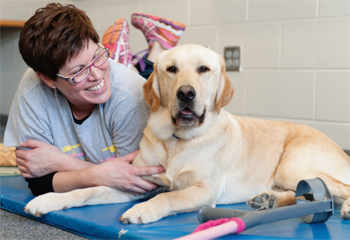
How a Service Dog Can Help
I was diagnosed with multiple sclerosis in June 2009. Never in a million years did I see a service dog as part of my future. I had absolutely no idea how a service dog would be able to assist me in my daily life.
As my disease progressed, mobility and fatigue became greater issues. In the summer of 2015, my health took a turn for the worst. I always had difficulty with fatigue and balance, as well as issues with my legs. However, I was now having difficulty walking, along with a new tremor that caused me to jerk so powerfully that I would lose my balance and fall. While I did not want to walk with a cane, I had to do so, and started using a wheelchair periodically as well.
My husband asked me if a service dog could be of benefit. I was baffled. A service dog? For mobility issues? I thought service dogs were only for people who are visually impaired. Thus, I began my search for just what exactly a service dog could do, for someone like me who had mobility issues due to MS.
The investigation into “all things service dog” was a double-edged sword. On one hand, the information on the role a service dog could play specifically in my life was awesome. I am a college professor and have very ambitious goals. Having MS is not going to interfere with those goals! On the other hand, as noted later, the search for a service dog would prove to be quite disheartening.
At this point in time, my MS had progressed to where I often dropped things, and those of you with balance issues know if something is dropped, you have likely thought, “Do I risk bending over and picking it up, only to land on the floor, or … just let that item stay right where it has landed?” Now, add the mobility issues into the picture.
Through my research, I found amazing information about the role a service dog could play in the lives of people who have mobility and balance issues, and even issues with fatigue. I discovered information on various organizations’ websites about the skills these amazing dogs could perform, such as picking up items that were dropped, opening doors, carrying items, helping people with balance issues to continue walking, and so on. Service dogs can also assist with maintaining independence. My heart was aflutter with joy.
Costs Associated with a Service Dog
While the assistance that service dogs can provide is awesome, what was not awesome was the cost of these dogs. During my search, I learned that some of the organizations charged anywhere from $25,000 to $50,000 per service dog. There was no way my husband and I could afford a dog at this price, despite the fact that we are both gainfully employed. It actually made me question how anyone – disabled or not – could afford such a steep fee for a service dog. Some organizations charged less, but only worked with people with specific disabilities, many of which did not include multiple sclerosis. Other organizations limited their clientele by a mileage radius, and unfortunately, I was not within that radius.
Because of that information, I put the search for a service dog on the back burner for a month or two. During that time, my mobility decreased further and I began using a wheelchair fulltime. I was scared now. I was limited with my ability to leave the house, go to the grocery store by myself, or take my daughter Sami to the local swimming pool. Independence was quickly slipping away.
About this Article
Editor’s Note
|
MSAA’s Client Services Specialists have received many inquiries about service dogs, including how they may be able to help someone with MS and how to find a service dog. We were very fortunate that Dr. Darbi Haynes-Lawrence, Associate Professor of Child and Family Studies at Western Kentucky University, generously volunteered to write this article for MSAA, sharing details about her journey of learning about, training for, and embarking on a new relationship with her service dog. While we hope that this information sheds light on the topic, we also recognize the fact that only a very small percentage of the MS population is able to receive a service dog. Finances, the ability to care for and maintain a service dog, as well as the small number of service dogs available, are all important factors that must be considered. For readers who are either not seeking a service dog or who are unable to obtain one, we hope that you will find this story about Darbi’s own challenges and her journey with Jaeger, to be both interesting and heartwarming. |
I worried about how my disease progression was impacting my daughter. Thankfully we are a very open and honest family, so we discussed this change in mobility. Our hope was that this was a relapse and things would improve after the relapse passed. Unfortunately, things did not improve as much as we hoped. My life was being detrimentally affected by my decreasing mobility, and some assistance was needed.
I decided one morning to try one more time to search for a service-dog organization. You might be thinking at this point, “Why not train your own dog?” Although this might be a wonderful option for some people, having a disease like MS – with fatigue as one of its major symptoms – made it impossible for me to be able to train a puppy on “all things service dog.” Although it is possible to train your own service dog, those who follow this path should thoroughly learn about the organizations that train service dogs. Really investigate and obtain an understanding of the depths of the training required during the first two years of a service dog’s life.
By a fluke, an absolute glorious fluke, I stumbled upon a program called the “Indiana Canine Assistant Network” or ICAN, which provided service dogs in my area. To locate a nonprofit organization in your state, please see the sidebar below.
How to Find a Nonprofit Service Dog Organization
|
During my search for a service-dog program, I kept coming across “Assistance Dogs International” (ADI). I saw that phrasing on some organizations’ websites, yet didn’t take the time to search the ADI site to look for a specific organization in my state. This was my error. Per their website, AssistanceDogsInternational.org, “Assistance Dogs International (ADI) is a coalition of not for profit assistance dog organisations [sic]. The purpose of ADI is to improve the areas of training, placement, and utilization of assistance dogs, staff and volunteer education, as well as educating the public about assistance dogs, and advocating for the legal rights of people with disabilities partnered with assistance dogs.” In order to assist in searching for a nonprofit organization, ADI is broken into categories. For example, to search in North America, ADI has a North American (NA) section: ADINA. By using this link, assistancedogsinternational.org/members/programs-search/, you can click on the region in which you live, then continue to narrow your search for a nonprofit service-dog organization in the area in which you live. |
Steps Needed…
…when Looking for and Applying to a Service-Dog Organization
|
|
Matching and Training for a Service Dog
You can imagine my shock when roughly six weeks after being placed on the two-to-four- year waiting list (as noted in the sidebar above), I was invited for a “matching.” This is the time when I would be paired with a service dog. At the matching, I met with trainers and worked with six different dogs to determine which dog would be the best fit for me. I cannot express strongly enough that this short time on the waiting list was an absolute stroke of luck and is quite uncommon.
I fell in love with one specific dog, Jaeger (sounds like “YAY-grrrr”). I cannot tell you what it was about my boy that clicked; it just DID! A few months later, I attended team training with Jaeger, which was two weeks long and concluded with a graduation ceremony. Because I lived some distance from where the training took place, I stayed in a hotel for the two weeks. I was responsible for all costs including housing, travel, and food. I also needed to take time away from work.
While training, I was taught cues, handling, and how to teach Jaeger new skills. We also worked together to begin the development of our bond. My journey with Jaeger had just begun!
My training with Jaeger extends beyond those first two weeks. I was required to return for “refresher training” twice within our first year together. After that, I can attend refresher trainings anytime I feel they are needed. The refresher trainings allow me to receive extra assistance with teaching Jaeger a new skill, or refreshing a skill that we haven’t used frequently and needs some improvement. I love these refresher trainings!
I am also required to complete an “end of the month” report for as long as I have Jaeger. This report is one method of communication with ICAN, and keeps them abreast of everything Jaeger and I are doing. The reports also allow me to describe any concerns I have with Jaeger. My favorite part of these reports is that it allows me to further celebrate all the successes Jae and I are having together.
Why Service Dogs are Not Given for Free
|
Part of the program’s interview process includes determining if a person is able to afford and adequately care for a service dog throughout his or her life. A rationale for the fee for a service dog is often a way for the program to help assure that the client will be able to financially care for the service dog. A service dog needs high-quality food, which is expensive, but this is what is best for him. He needs to stay in top working shape, so he can provide amazing care for the person he cares for, and it’s only fair that he is provided with amazing care as well! |
How ICAN Trains Service Dogs
ICAN’s training program is, quite simply, amazing! ICAN has a dual mission: The training of service dogs, along with the education and rehabilitation of incarcerated adults. ICAN service dogs are cared for and trained in three Indiana Correctional Facilities. Female and male offenders, referred to as handlers, are the trainers of the service dogs. The handlers apply to and are carefully screened by the ICAN program.
At this point, you might be questioning the idea of involving prisoners with the training of service dogs; however, ICAN believes that everyone has the potential to give back to their community. “Although society must hold offenders responsible for their behavior, we also need to provide them opportunities to learn skills that can help them grow into productive and responsible citizens” (Correctional Facility Training, 2015). It is not uncommon for nonprofit service-dog organizations to use correctional facilities to assist in training service dogs. ICAN is one of three programs where the team training occurs within the prison.
Handlers take classes within the correctional facilities to learn skills that may allow them to get a job once their sentence is complete. During their time in the ICAN Program, “The handlers develop life skills such as responsibility and accountability, compassion, teamwork, pride, self-esteem, unconditional love, discipline, and the use of logic over emotion to achieve goals” (Positive Impact on Offender and Family, 2015). Job skills for the handlers means a decrease in recidivism (re-offending) rates.
The level of hands-on training that is provided by the handlers is priceless. The service dogs live with the handlers for two years, rotating between the correctional facilities and community-based furlough volunteers. The handlers teach the service dog skills, while the volunteers continue the socialization process for the dogs in training. During the two years of training, all dogs are on a rotation of six weeks in prison and three weeks out with volunteers. This rotation assures that the dogs are continually socialized and can perform their skills out in public.
During team training, I felt completely safe with my handler. I actually forgot where I was on most days, as the set up for the training was in a building much like a school – with classrooms, a library, cafeteria, and gymnasium. Working in the ICAN program is an honor for the handlers, and something in which they take great pride. I am eternally grateful to the handler who trained Jae.
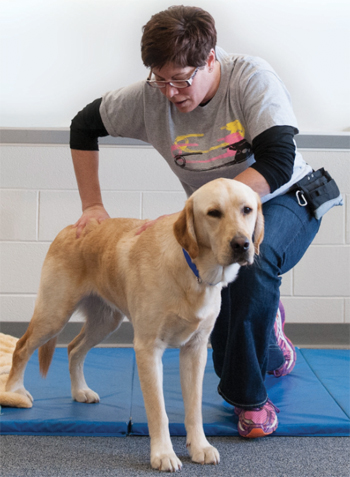
Darbi demonstrates how Jaeger provides support and helps to maintain her balance as she pushes herself up from the floor.
Tasks Performed by a Service Dog
Earlier in this article, I mentioned some of the skills that service dogs can perform. Jaeger was trained on more than 75 basic skills. Even more importantly is the fact that he is trainable, and so am I! This means that as he and I go through life together, new skills can be taught at any time. My primary issues are balance, mobility, and fatigue. The skills I am about to describe are only some of the skills that Jaeger performs. It is by no means an exhaustive list!
During team training, I was taught how Jaeger can “brace.” To brace means that if I am on the ground and need assistance getting up, Jae stiffens his body to provide support. I put my left hand on his shoulders, my right hand on his rump, and use him to help balance and push myself up.
When I was learning this skill, I felt horrible. I’m a larger gal and I did not want to put my weight on Jaeger. I was on the ground a lot during team training (by my choice, so I could be closest to Jae) and every time I got up, I would not have Jae brace for me. An ICAN volunteer who was in the training with me, finally said, “Look – the more you use Jaeger to assist you, the less fatigue you will have. The less fatigue you have means the more energy you will have for your daughter.” Having Jaeger was one thing; using him was another. I was afraid that by using Jaeger, I was being lazy. This guilt quickly subsided as our bond became stronger and I recognized Jaeger’s desire to help me throughout daily living.
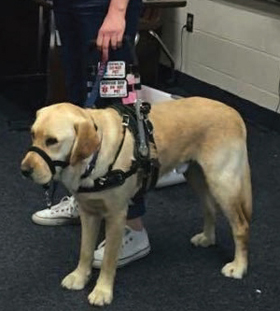
As previously mentioned, balance is a major issue for me. Jaeger assists me with my balance while I walk. He wears a “balance harness” (pictured) that I grip with my left hand while I walk. If I experience a strong tremor, I grab ahold of the balance harness. Jaeger will “counter-pull” if I begin to fall backwards (he will pull forward). This can happen in a split second. I am absolutely amazed that he was trained to recognize this very slight, but frightening movement. I could easily fall when these tremors occur.
Jaeger assists with walking up and down stairs. At home, the stairway is odd and doesn’t have a full handrail. Jaeger assists me up these stairs by walking slowly by my left side, while I have my hand on his shoulders. This allows me to maintain my balance going up and down the stairs. I am in awe with how he waits for me to maneuver up and down the stairs, moving at my pace. We frequently use this skill in public, especially when no elevator is available.
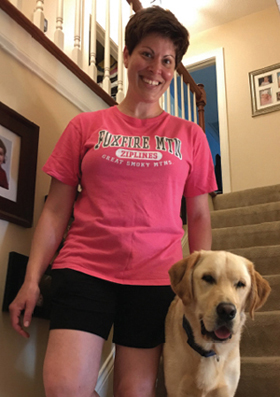
When fatigue is at its worst and I’m resting on the couch, I have trained Jaeger to get a blanket for me from our cabinet. He opens the cabinet door by pulling on a rope that has been tied to the handle. He pulls the blanket out with his paw, picks it up, and brings it to me. He then returns to the cabinet, and using his nose, pushes the door shut. I cannot stress strongly enough that I would not have been able to teach him this skill, if he didn’t have such an amazing foundation of learning, and had I not been trained how to teach him.
The handler trained him to open the refrigerator door by tugging on a rope tied to the refrigerator. He then gets a bottle of water, shuts the door, and brings the bottle of water to me. Most drawers, the dishwasher, the refrigerator, and door handles all have small ropes tied to them so he can pull them open for me. He uses his nose to close things.
He assists with removing the sheets from the bed on laundry day. I use the “tug” command when asking him to remove the sheets. He will pull the sheets with his mouth. He’ll then drag the sheets to the laundry room for me and put them in the washing machine.
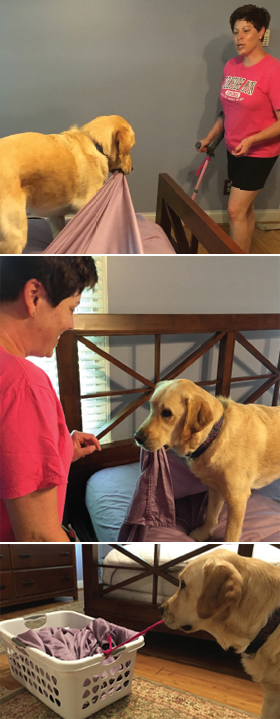
One of my favorite things to watch Jaeger do is to drag the laundry basket full of clean clothes over to me. The laundry basket has a rope attached to it, and Jaeger uses this rope to “tug” the basket to me. He is so silly when he is executing this skill and prances all the way to me. While training, I was told Jaeger loves to work, and it’s true!
While we are at my job on campus, Jaeger assists me by carrying things to the classroom and picking up what I drop. Most frequently I drop my keys and my phone. He is quite adept at picking up my phone and handing it to me. It’s interesting to me that he was taught to pick up my phone by the edges, and not put his teeth on the screen of the phone. When I’m in my wheelchair, closing my office door is difficult. Jaeger pulls my door shut by tugging on a rope that has been tied to the door handle.
During long days on campus, I tend to use my wheelchair as my tremors increase as I become fatigued. I do not like lecturing from my wheelchair, so I use a tall chair in my classrooms. Jaeger assists me in transitioning from my wheelchair to the tall stool by “pulling” me from my chair by tugging on a rope that I am holding horizontally. He then pushes my wheelchair over to the corner of the room. When I’m ready to go back into my wheelchair, he pulls the chair to me by pulling on a rope tied across the wheelchair frame. He assists me in transitioning back to the wheelchair. He also opens and closes the classroom door for me as well.
When we are at home, lying on my legs is a physical skill that Jaeger performs to assist with pain management. On occasion, the spasticity in my legs is quite painful. By lying on my legs, his body weight puts pressure on those muscles and it feels phenomenal!
Jaeger can get my shoes for me. I say, “Jaeger, get shoe!” When I need something that hasn’t been named, I point to the object and say, “Jaeger, get!” He can retrieve pens, pencils, and even pick up a debit card straight from the floor!
The Challenges of Being Partnered with a Service Dog
Extra Care Required
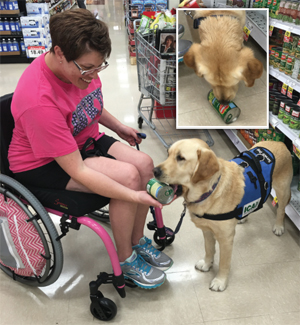
Jaeger has been taught commands to pick up any item Darbi requests, which is very helpful both at home and at the store.
Service dogs require more care than a pet. I had never given much thought to the care a service dog requires until team training. Service dogs must be exercised 30 minutes a day, or have access to a large, fenced in yard so they can exercise – such as running after a ball. Jaeger’s weight is carefully watched for
health reasons.
They must be groomed frequently, teeth brushed twice a week or more, ears cleaned and nails trimmed once a week or more, plus they need to be bathed more frequently than the average pet, and so on. It is imperative that a service dog is well cared for, as they are highly trained dogs that in order to continue working, they must be healthy!
Continuing with care, a service dog’s training never ends. Jaeger and I work on “cognitive” training every day, for a minimum of 30 minutes. We play games that promote thinking and problem-solving, practice skills that aren’t used daily, and review those cues or skills that I notice he isn’t performing well. I teach him new assistive skills constantly.
Finally, if you have a disease such as MS, and your MS brings with it a good deal of fatigue, you need to know if you are able to provide this daily care for your service dog. What happens if I experience fatigue or even a relapse? Jaeger’s care needs to be provided by someone if I am unable to care for him, because of my MS. That is where my family steps in.
During the interview process, I was asked who would help me care for a service dog if I was sick or having an exacerbation. I have a great “team,” which is made up of my husband, Greg, and my daughter, Sami. They are my “immediate-assistance” team. My “extended-assistance” team includes my parents. All of these people are around Jaeger frequently.
Unwanted Attention
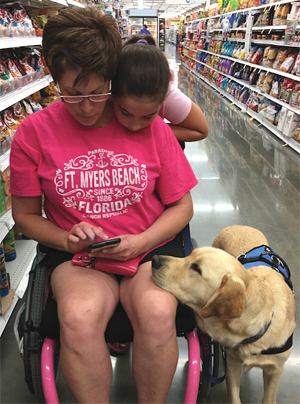
Service-dog Jaeger watches as Darbi and her daughter Sami calculate their purchases. Time alone is rare when in public, as people often try to pet and even taunt Jaeger.
I am often asked, “Isn’t it the coolest thing to have a service dog?” and told, “I wish I could take my dog everywhere, too! My dog is so smart!” While it is absolutely amazing to have Jaeger, I caution readers to think long and hard about obtaining a service dog. The attention you will receive – warranted or unwarranted, wanted or unwanted – from the public, does not stop.
It might seem really neat at first, but after a few months, a quick trip to the store is no longer a quick trip. My family and I joke that the community responds as if they are seeing a unicorn, not a dog. Finally, laws are in place to assist and protect those of us with service dogs that allow us to enter public businesses. However, not everyone in these public businesses is aware of the laws with regard to having our dogs with us in public, and has difficulty seeing past “a dog in the store!”
During our team training, we were educated that having a service dog means we will receive unwarranted attention. At first, my family and I were so excited to have Jaeger with us when traveling together in public.
Most people are fascinated by service dogs, but we learned very quickly that a lot of people in the community don’t seem to have boundaries when it comes to Jaeger. It was as if he was inviting people to “pet and speak to me.” The first time we went to the local store, we were bombarded by people trying to touch Jaeger as he walked by, with people barking and making noises at him, and others saying, “Look, a DOG!” People wanted to tell us about their dogs, when all we wanted to do was grab a gallon of milk!
Jaeger and I have been matched for a year now, and the public response has yet to go away. We had been trained how to respond to people who wanted to pet him, by saying, “No thank you, he is working.” We are asked constantly by strangers if they could pet Jaeger. I have been told I was “mean” by more people than I can count, simply because I would not allow them to pet my service dog. This is all despite the fact that Jaeger has two patches on his gear that say, “Working dog, do not pet!” But regardless of how those around us were acting, I was always friendly and polite in my responses, even when I didn’t want to be.
On one occasion, we were eating dinner at a restaurant and an older couple came over and sat down at our table. The gentleman said to me, “What is so wrong with you that you need a service dog?” This kind of thing is more commonplace than I had ever realized. Is it ok? Absolutely not, but it hasn’t all been negative. We’ve also enjoyed talking to many children about Jaeger and how he helps me.
Teaching the Community about Service Dogs
As an educator, I just knew something could be done about the responses from our community, toward Jaeger and my family. My primary concern wasn’t for us, but for those people who live with other conditions where stress can trigger a negative health response, such as a seizure.
First, I needed to learn to ignore people who barked at us or made other noises at Jaeger as we walked by them. I’ll be honest; it is a terrible feeling to have this happen. I would love to say that the group we have the most difficulty with is children, but it is not; it’s adults. Parents encourage their children to bark at Jaeger, and as parents, Greg and I are simply astonished by this behavior. We’ve learned from experience that if we ask them to stop, they typically bark louder. Adults get very vocal with their anger toward me because I won’t allow them to pet Jaeger while we are working.
Second, being a person who believes that education is very important, we decided to develop a small program to educate the public about how to behave around service dogs, starting with children. We selected three educational points that we wanted children to learn from our presentations on service dogs, and designed pencils with puppy paws to give to attendees. I contacted the elementary school where Sami attended, and Jaeger and I began giving presentations to each classroom, from kindergarten through fifth grade.
So far, we have educated 614 elementary-age students and 20-plus teachers about service dogs. The children love the pencils and are eager to learn about Jaeger. Our plan is to expand our educational program to other elementary schools during the next academic year. Our hope is that the young people will educate their parents on appropriate behavior around service dogs.
The Americans with Disabilities Act

Practicing their skills in the classroom, Darbi asks Jaeger to retrieve her cane for her. Jaeger knows to pick up the cane by a small rope tied near the handle, and these types of small ropes are tied to many door and cabinet handles throughout Darbi’s house.
Earlier I mentioned how many people comment about the “coolness” of having a service dog. The growing number of people with “fake” service dogs is astounding. I understand that people love their pets and want to take them everywhere. However, the service dogs who are not “real” are a big problem.
First, according to the Americans with Disabilities Act (ADA), in order to have a service dog, you must have a disability, and the task(s) trained will be specific to the person’s disability. For example, when Jaeger is wearing a walking harness, he assists me with walking and balance.
Second, Jaeger is not with me because I like having my dog around. He performs a service similar to what I gain from my medical equipment, which allows me to walk safely.
A service dog is able to go into stores, restaurants, and other locations not because he is a service dog, but because he is with a person who has a disability. Now, if my husband Greg took Jaeger into a grocery store, and I was not there, Jaeger would not be allowed in the store. Jaeger is allowed accessibility to locations because he is with me, providing a service similar to the assistance that durable medical equipment would provide to a person with a disability.
Continuing with accessibility, and I have thankfully not experienced this yet, people with service dogs cannot be denied entry into public places, such as stores, malls, and restaurants. A proprietor of a location, or its employees, can ask a person with a service dog two specific questions only. According to the ADA’s publication, Service Animals, “When it is not obvious what service an animal provides, only limited inquiries are allowed. Staff may ask two questions: (1) is the dog a service animal required because of a disability, and (2) what work or task has the dog been trained to perform. Staff cannot ask about the person’s disability, require medical documentation, require a special identification card or training documentation for the dog, or ask that the dog demonstrate its ability to perform the work or task.”
With regard to “fake” service dogs who are not professionally trained and serving an individual with a disability, one clue that this may not be a real service dog is if the owner indicates that his or her dog is a “certified service dog.” There is no such thing as a certification for service dogs. Unfortunately, a few online companies will, for a fee, provide a “certification” for your dog to be viewed as a service dog. Many companies will also sell service-dog vests. I dislike these companies; it is a disservice to real service dogs and to the individuals with disabilities who rely on their vital assistance.
How Jaeger Has Changed My Life

About the Author
Darbi Haynes-Lawrence, PhD is an Associate Professor at Western Kentucky University in the Child and Family Studies unit. She uses her experiences as a researcher and a person living with MS to educate as many people as possible about the disease. As well as conducting, publishing, and presenting research, she is passionate about teaching.
During team training, I shared with my graduating ICAN class members – who were also each receiving a service dog – how I found that being partnered with a service dog can be bittersweet. On the one hand, how amazingly exciting to begin this journey! Having a service dog, like Jaeger, allows me to be more independent, assist with my balance, have someone to get those pesky things I drop, and help me conserve energy that I can thankfully spend with my daughter.
However, on the other hand, throughout this exciting journey of applying for the ICAN program, interviewing, home visiting, and matching, I could no longer hide from the changes I was experiencing. Getting a service dog also means, for me, my disease has progressed. I now need assistance. Many people with MS have experienced this loss of their “old self.” And like those people, I have learned to adjust, and appreciate my new normal, which includes an amazing new partner.
If we reflect on the reasons why those of us were fortunate enough to receive a service dog, I hope that each of us can see how the “new you” is better than the “old you.” My new me is invested in the MS community, how we can help parents with MS become the best parents they can be, access services needed to live successful lives, and to parent their children to the best of their abilities.
I am also an advocate for service dogs. My new me, although not as athletic, is still able to share my humor with my daughter; model perseverance through times of challenge, and let me just say my favorite part is – I can love my daughter just as much, if not more, than the old me could ever imagine.
Since bringing Jaeger home, I have noticed changes. I no longer sit at home, waiting for someone to go with me to specific locations. I actually exercise a little more, because I have someone to help me walk (YAY for JAE!). The exercise has actually aided in the decrease of my ever-present fatigue. My spirits have been lifted. I am much more engaged in the community now.
Ever the educator, I feel strongly that young people need to be educated on service dog awareness, and how to behave around service dogs. Because of the assistance Jaeger provides, I am no longer fearful of the grocery store, and the worry of falling – while walking across campus or during a lecture – is gone.
Yes, Jaeger helps me with things such as mobility and picking up what I have dropped, but it’s more than that. It’s independence. It’s strength. All of those things that I had lost were returned to me when I embarked upon getting help… and this help was packaged in the body of a pup named Jaeger.
References
Correctional facility training
www.icandog.org/indiana-offenders
Positive impact on offender and family
www.ada.gov/service_animals_2010.htm
ADA’s publication, Service Animals

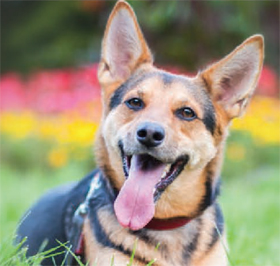 Darbi explains the process she needed to follow in the steps shown below:
Darbi explains the process she needed to follow in the steps shown below: Confirm Location
Confirm Location Consider Affordability
Consider Affordability Complete the Application
Complete the Application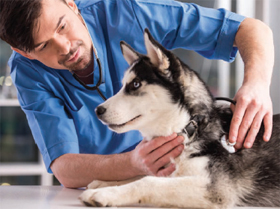 Service dogs are typically not given to people for free. There is a considerable range in the fee for a service dog, whether that dog is from a not-for-profit or a for-profit program. Nonprofit programs, like ICAN, use fundraising to help offset the cost to the recipient. A reason behind the fee is that service dogs require a lot of care throughout their lives. Remember, they are not pets. The care required includes veterinary visits, quality food, and preventative care, all of which can add up quickly. An added cost for a service dog is insurance, just in case any accidents would occur. For example, if the dog gets hurt while running across the backyard, the person or family he serves is required to pay for any and all injuries.
Service dogs are typically not given to people for free. There is a considerable range in the fee for a service dog, whether that dog is from a not-for-profit or a for-profit program. Nonprofit programs, like ICAN, use fundraising to help offset the cost to the recipient. A reason behind the fee is that service dogs require a lot of care throughout their lives. Remember, they are not pets. The care required includes veterinary visits, quality food, and preventative care, all of which can add up quickly. An added cost for a service dog is insurance, just in case any accidents would occur. For example, if the dog gets hurt while running across the backyard, the person or family he serves is required to pay for any and all injuries.